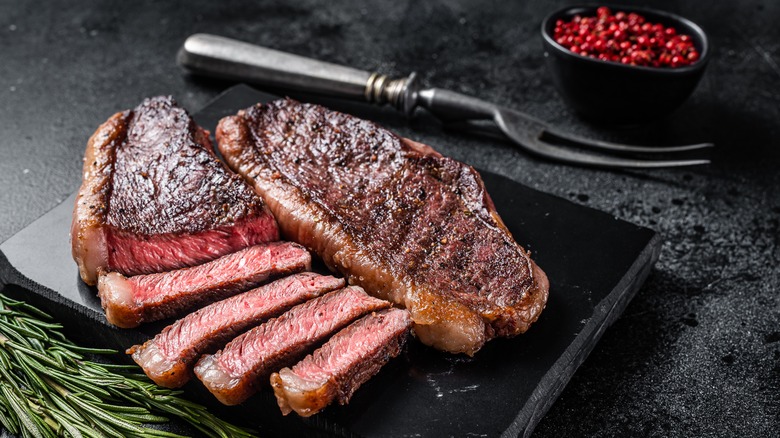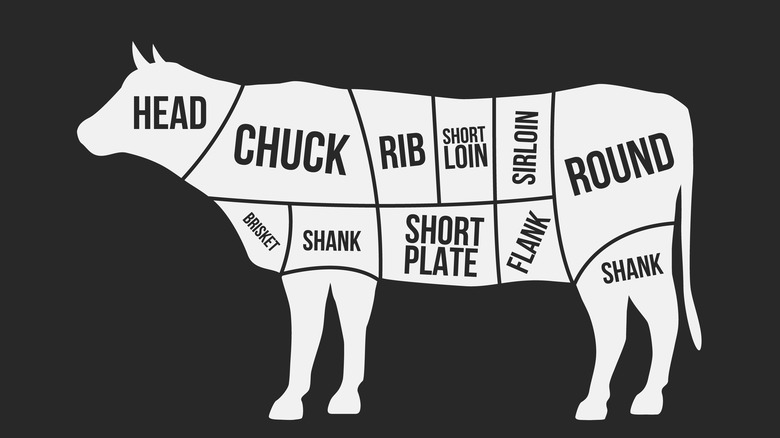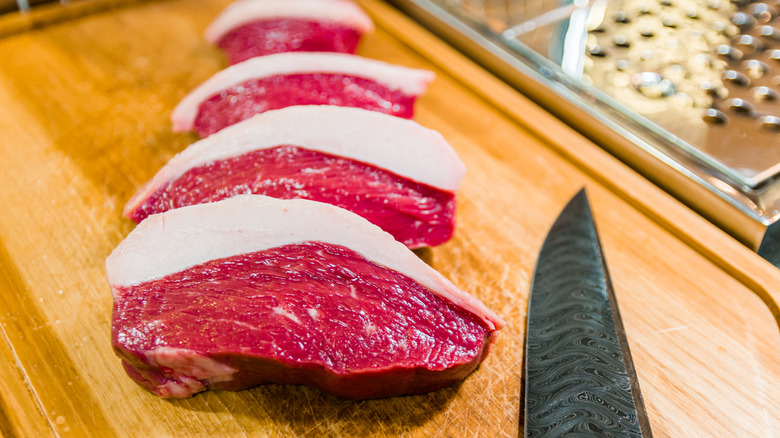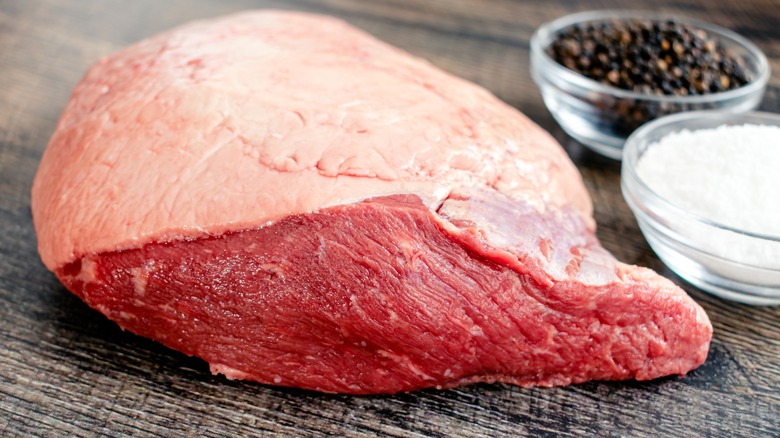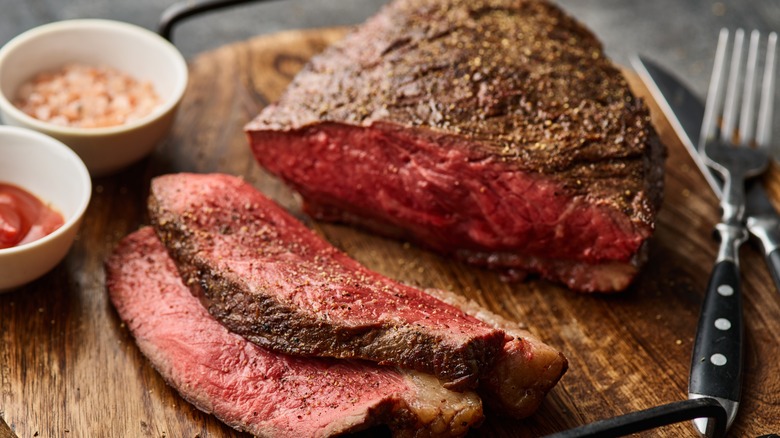Look To The Coulotte Roast For Ultra-Juiciness And Flavor
Let's face it, sometimes the choices of beef cuts at the grocery store butcher counter and meat section can get boring. It's the same popular cuts piled high; steaks like tenderloins, ribeyes, and T-bones; large roasts like chuck and round; and utility meats like ground beef and chunks for stewing. This is, of course, with good reason, but it can leave a seasoned cook seeking a more interesting cut. Luckily, there are plenty of those available, if you know where to look and who to ask. One such overlooked and underrepresented piece of beef is the coulotte roast, a large, flavorful cut that deserves attention.
This beautifully-marbled roast bursts with the rich flavor of steak. It is big enough to feed a hungry crowd of friends and family, and can be cooked in a variety of ways, including on the grill, making it perfect for summer cookouts. While locating a coulotte roast may take some legwork, it will be well worth it.
What is the coulotte roast?
The coulotte roast comes from the section of the cow also known as the sirloin cap, which sits towards the upper rear portion of the animal. The sirloin primal — commonly broken down into the top sirloin butt and bottom sirloin butt — produces a number of other cuts such as the tri-tip, sirloin bavette, and petite sirloin steak. Coulotte roast is derived from the sub-primal top sirloin butt. The difference between these two sub-primals (besides location on the cow) is marbling. The bottom sirloin butt is a leaner piece of meat, and thusly less flavorful and tender. The top sirloin butt, located not far from the coveted tenderloin, is rich with marbling. That's what makes the coulotte roast such a tasty piece of beef; it's a triangular-shaped muscle that sits on top of the sirloin with a pronounced fat cap in addition to all that intramuscular marbling.
Regarding the name, coulotte may be derived from a French word meaning "cap" owing to its location within the sub-primal, but there is debate over the matter. Some have argued that coulotte is rather pulled from the French "cul" meaning bottom in the anatomical sense. Regardless of the origin, coulotte as a term for roasts has stuck as a seemingly-refined name for an often overlooked cut.
What does the coulotte roast taste like?
The first thing that catches the eye is the coulotte roast's fat cap, sitting like a thick white blanket over the deep-red, striated meat below. This can turn some people off, but it's one of the signature features of the cut and why many others love it. While some cooks prefer to have this removed by their butcher — and some butcher's remove it automatically — the fat cap contributes much to the flavor of the coulotte roast and helps keep the meat moist while cooking.
Fat, of course, is largest contributor of flavor to beef, so the fat cap and marbling of the coulotte roast are a big part of the draw. They lend to a rich and deeply flavorful experience unlike leaner cuts that can be rather insipid. While not as marbled as a ribeye, and thus not quite as strongly-flavored, the coulotte roast is not far off from a strip steak or strip roast, and it is often sold for a fraction of the price. What's more, it is relatively light in the calorie count, clocking in a 210 calories on average for a 4 ounce portion. That makes it a great option for those being mindful of their overall caloric intake.
Cooking the coulotte roast
Coulotte roasts are versatile and perform well classically roasted in a medium heat oven or on the grill for a smokier affair. While you can cook it to your liking, coulotte roast is generally served medium rare to allow for maximum juiciness and for its beefy flavor to shine. To prepare, start by seasoning the meat generously with salt, pepper, and any other desired spices or herbs. Preheat your oven to 375 degrees Fahrenheit or set up your charcoal or gas grill for indirect cooking.
If you're using the oven, insert a meat thermometer into the thickest part of the meat and place the seasoned roast on a rack in a roasting pan with a little bit of water in it. Cook until the thermometer reads 125 to 130 degrees Fahrenheit for medium-rare, or adjust the temperature according to your preference. As a general guideline, it will take approximately 12 to 15 minutes per pound to reach medium-rare.
For the grill, start by searing the coulotte roast directly over the coals to develop a crust on all sides. Then move it to the cool zone of the grill, close the top, and continue cooking until you've reached your desired internal temperature.
When cooking is complete, remove the roast and let it rest for 10 to 15 minutes. This resting period allows the juices to redistribute, resulting in a more tender and flavorful meal. Slice the coulotte roast against the grain into thin slices for optimal tenderness.
Where to buy coulotte roast
As mentioned above, finding a coulotte roast is not as simple as picking one up at the grocery store. It's possible that they'll have the cut available, and, if you don't see it, check for sirloin cap roast. If not, then it's time to make friends with your butcher, either at the grocery store or at a specialty butcher shop. They are more than happy to fulfill special orders, so ask them to reserve a coulotte roast for you. Butchers can often provide valuable guidance in regards to cooking methods, seasoning, and other cuts of beef you may enjoy.
Speaking of other cuts, there are a couple of others that are associated with the same muscle. One cut that is particularly popular in South America is the picanha steak, which is also a thick, triangular-shaped steak with the thick fat cap left intact often grilled on a skewer to medium-rare or medium doneness. Another cut seen at steakhouses is the baseball steak, which is a roughly round — hence the name — boneless cut from the same muscle as the coulotte roast. Baseball steaks are equally versatile and can be prepared using various cooking methods such as grilling, broiling, or pan-searing. Both picanha and baseball steaks are excellent choices for meat lovers who enjoy the robust flavor and tender texture of the coulotte roast. Give them a try if you're looking to explore a smaller portion of this flavorful cut.
